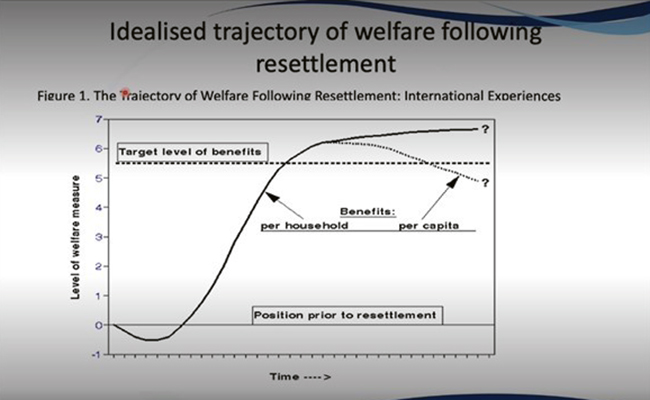News & Media
The trajectory of welfare following resettlement Zimbabwe vis-à-vis international experiences
The South African Research Chairs Initiative (SARChI) in the College of Graduate Studies recently hosted an impactful webinar. Dr Newman Tekwa, a postdoctoral fellow in the Department of Science and Innovation/National Research Foundation (DSI/NRF) SARChI Chair in Social Policy, shared a presentation on the welfare trajectory of resettled households and international experiences and lessons learned in this regard.

Dr Newman Tekwa
Land continues to have currency at both regional and global levels. Generally, access to more significant areas of land enhances the income and welfare of households. According to the presented idealised trajectory of welfare following resettlement in Zimbabwe (see Figure 1 below), welfare levels initially declined as households experienced a period of stress and adjustments. Unfortunately, not all families recovered from such a decline. Once adjustment occurred, the welfare levels increased until the target level of benefits for access to land was reached. However, the per capita benefit would begin to decline if the number of household members naturally increased. The larger economy proved not to be dynamic enough, and people were not absorbed in an economy that was not directly dependent on agriculture. As a result, households remained solely reliant on the land.
Aspects such as asset accumulation, quality of housing, cattle ownership, and household consumption were studied. Findings indicated that access to land enhanced the household income and welfare of resettled households. In addition, families used revenues from crop and livestock sales to improve their welfare.
Figure 1. The trajectory of welfare following resettlement
According to the findings of research conducted in 2016, households that had been resettled on medium-sized farms (A2 farms) enjoyed greater welfare than households resettled on smaller farms (A1 farms), while communal farmers (the control group) continued to enjoy minor welfare. Asset accumulation was investigated. It was found that 40.6% of participants on A2 farms (medium farms) owned tractors, while only 12.1% on A1 farms (small farms) owned tractors. None of the participating communal farmers owned a tractor. It was also found that 90.6% of participants on A2 farms and 30.3% on A1 farms owned cars, while none of the communal farmers owned a car.

Figure 1
42.5% of the communal participants still lived in pole and dagha houses. The corresponding percentages among participants on A1 and A2 farms were 18.2% and 0%, respectively. Statistics indicated that the diets of A2 and A1 households had improved significantly. However, a more significant number of participating households in the control group experienced food shortages, indicating poverty.
In conclusion, Tekwa said that land reform remained a better social policy (welfare) intervention than either food or cash transfers, particularly where land distribution still favoured particular social groups to the exclusion of others. Indications were that access to land without agrarian support had a negative effect on the shape of the curve, which tracked the growth of welfare. Government interventions would also be needed to improve the welfare of people through policies and intervention in the economy. Access to land enhanced the welfare of resettled land-beneficiary households. However, non-land beneficiary households in communal areas did not enjoy the same level of welfare as land-beneficiary households.
A new research project undertaken under the auspices of the SARChI Chair is entitled the Social Policy Dimensions of Land and Agrarian Reform in International Perspective. This project will continue to track the welfare progression of land reform beneficiaries to determine whether land and agrarian reform should be used as a social policy instrument, particularly in development contexts.
* By Hanli Wolhuter, Communication and Marketing Specialist and Musa Buthelezi, Intern, College of Graduate Studies
Publish date: 2022-11-24 00:00:00.0

 Unisa academics join hands to celebrate World Social Work Day
Unisa academics join hands to celebrate World Social Work Day
 Unisa community engagement initiative targets school underperformance
Unisa community engagement initiative targets school underperformance
 Library tour introduces learners to the wonderful world of Unisa
Library tour introduces learners to the wonderful world of Unisa
 Unisa Radio volunteer wins prestigious community journalism award
Unisa Radio volunteer wins prestigious community journalism award
 Unisa's student leadership engage with Russian ambassador
Unisa's student leadership engage with Russian ambassador